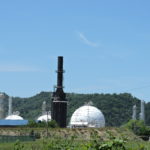Fracking Effects Worry Doctors in Barnesville, Freeport

Photo by Casey Junkins The Blue Racer Midstream natural gas processing plant in Marshall County is undergoing yet another expansion.
WHEELING — Dr. Russell Lee-Wood said when he began practicing family medicine in the Barnesville and Freeport areas 21 years ago, the breathing problems he diagnosed in patients were relatively rare or minor.
During the last six years — as Marcellus and Utica shale frackers have installed well sites, compressor stations, processing plants and related infrastructure in eastern Ohio — Lee-Wood said cases of asthma and emphysema have become more common and severe. The situation is especially bad when there is significant flaring taking place, he said.
“These industrial leaks are like an invisible oil spill happening every day. I have seen firsthand that this pollution can cause significant health problems in my patients who live in the communities surrounded by oil and gas development,” Lee-Wood said.
Three national environmental advocacy groups joined Wednesday to launch the “Oil & Gas Threat Map.” The sponsors include the Clean Air Task Force, Earthworks and the Fractracker Alliance.
“The Oil & Gas Threat Map shows that oil and gas air pollution isn’t someone else’s problem, it’s everyone’s problem,” Earthworks Executive Director Jennifer Krill said. “Our homes and schools are at risk while most state regulators do nothing. Although completely solving this problem ultimately requires ditching fossil fuels, communities living near oil and gas operations need the U.S. Environmental Protection Agency to cut methane and toxic air pollution from these operations as soon as possible.”
In multiple legal advertisements during the last few years, natural gas producers have confirmed the potential to discharge various materials into the air from the operations at well sites, compressors and refineries.
Now, residents can view for themselves how close they may live to areas with such pollution at oilandgasthreatmap.com.
At the site, one can enter his or her address to determine how poor the local air quality is, according to the environmental advocacy groups.
“This is an important new tool for Ohioans, who can enter their own address, find out if they live within a threat zone and see if their community has an increased risk of cancer and respiratory health problems due to oil and gas related air pollution,” Melanie Houston, director of oil and gas for the Ohio Environmental Council, said.
Local counties that feature the highest level of oil and natural gas activity also have the highest levels of air problems, according to the map. In Ohio, Carroll County has several areas rated “above EPA’s level of concern,” but Belmont, Jefferson, Monroe and Harrison counties also feature hazardous zones, the maps show.
“The trouble is that it hangs over the area,” Lee-Wood said of the pollution from flaring. “Maybe you can stay indoors, but that is like being in prison. I really wish the EPA would start doing some air monitoring to deal with this.”
In West Virginia, heavily drilled Wetzel County exceeds the EPA level of air pollution associated with a risk of cancer, as does Tyler County. Marshall and Ohio counties are at a slightly lower risk, but Houston said these ratings do not account for additional pollution caused by coal-fired power plants.
Methane is the primary component in natural gas. Obama administration officials want to cut methane emissions from the oil and natural gas industry 45 percent by 2025, but this may not be good enough for Barnesville resident Jill Hunkler.
“Right now, the oil and gas industry is needlessly leaking millions of tons of methane pollution and toxic chemicals into the air that harm our health and speed up climate change,” she said.
Officials with the Washington, D.C.-based American Petroleum Institute say the increased use of natural gas to generate electricity helps the environment because this results in less coal burning, which in turn leads to less carbon dioxide pollution.
“Hydraulic fracturing has allowed us to drill our way to reduced greenhouse gas emissions, reduced criteria pollutants, reduced reliance on imported energy and lower gasoline prices,” API Upstream and Industry Operations Director Erik Milito said.
“The industry is already leading the way on methane reductions because it is good for the environment and good for business,” API Vice President of Regulatory and Economic Policy Kyle Isakower added. “Even as oil and natural gas production has risen dramatically, methane emissions have fallen, thanks to industry leadership and investment in new technologies.”






